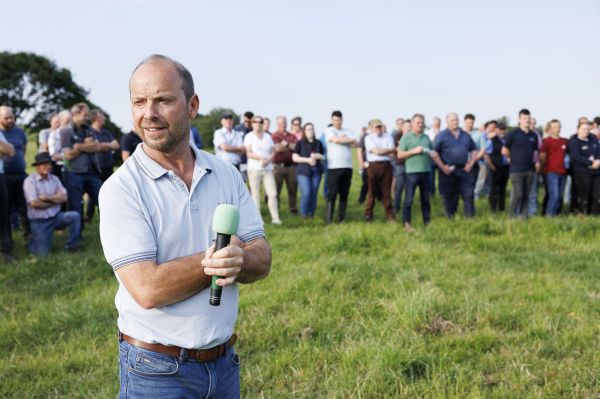Innovation through genetics

Chris works full-time off the farm, but the level of detail evident on the farm simply does not happen without a lot of hard work, dedication, drive, and determination. The beef system in operation is probably best described as being meticulously planned simplicity.
The set up
And, a simple system it is. The three-quarter bred Limousin cow type has power, milk, calving ability, strong carcass characteristics and fits perfectly into the McCarthy’s system. A terminal Charolais stock bull – which Chris bred himself – is used to produce top-quality U- and E-grading bulls and heifers.
The 46-cow, spring-calving herd calve in a tight block early in spring and get to grass typically in February where they are rotationally grazed on a well-set-up paddock system, so one person can move stock at any time on their own. Well-managed swards combined with good soil fertility result in over 11t DM/ha of grass being grown from a relatively low chemical nitrogen input at just 125kg/ha (102 units/acre).
The herd
This high-quality grass is efficiently converted to live weight through a milky cow and by a calf with a high-genetic ability culminating in the consistent production of heavy weanlings in September, averaging 290kg for heifers and 330kg for bulls. Heifers are sold to a local farm in October each year at around 320-330kg average weight. The bulls are housed in early November at roughly 380-400kg where they go on to be finished at under 16-month bulls.
The bulls consume around 1.8t/head concentrate lifetime and have an average carcase weight of 478kg at 15.9 months of age. That translates to a lifetime performance of almost 1kg carcase/day. While these are heavy carcase weights, Chris works closely with his processor and they know he can deliver high conformation carcases with sufficient fat cover.
Stocking rate and output
The farm extends to 28ha which is all in one block. This aids labour management around moving stock thoughout the grazing season. The overall stocking rate on the farm is 2.05LU/ha. While this is almost double the average suckler farm in the country, the stocking rate is not excessive with Chris under the 170kgN/ha limit. A high level of output is what is driving the entire system. There was 769 kg/ha liveweight or 374kg/LU produced in 2022. From a financial perspective, this translates to a gross output of €2,580/ha and a gross margin, before any support payments, of €1,283/ha.
High performance
The McCarthys achieve a long grazing season of over 270 days which maximises the proportion of grass in the diet and keeps production costs as low as possible in the cow-calf unit. Indeed, grass and grass silage account for over 80 per cent of the total feed used on the farm – considering that there is a bull-beef system in operation and heifers are sold as weanlings, this shows there is a high level of performance coming from grazed and conserved pasture.
Almost 90 per cent of the farm has a soil pH of greater than 6.2. The entire farm is index 4 for phosphorous (P) and 88 per cent of the farm is index 3 for potassium (K). Higher fertiliser prices in recent years have seen Chris reduce the use of compound fertiliser, which has resulted in K levels dropping on some parts of the farm. This is something Chris is eager to correct in the coming years.
During the main grazing season, there are just two grazing groups, which means two things. Firstly, it is easier to manage fewer groups and secondly, there is significant grazing pressure through big group numbers so that once the group enters the four-acre paddocks they graze them out in three days and then move onto fresh pasture.
Animal health
The third stop of the evening focused on animal health. Chris is minimising the risk of purchasing replacements by using the same few farms each year for his stock, while the bulls are on a pneumonia-vaccination protocol prior to housing in autumn to minimise the risk at housing time. Chris is also using quiet wean nose paddles which he says takes the stress out of the weaning process.
In conclusion, the success of the farm could not be attributed to any one thing and it is the sum of all the individual parts and the attention to detail that is observed. The right cow for the system, good genetics that deliver high growth rates, excellent grassland management, a time-efficient system, achieving high output per livestock unit and – ultimately and most importantly – consistently delivering a financial dividend at the end of the day.




